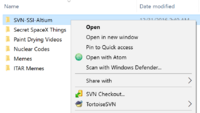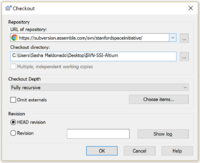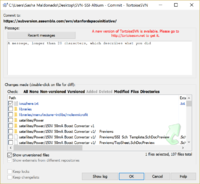Difference between revisions of "SVN"
| Line 21: | Line 21: | ||
===Exploring an SVN Repo=== | ===Exploring an SVN Repo=== | ||
The [https://ssi-svn.stanford.edu/ ssi-svn.stanford.edu] page should now show a list of all the SSI SVN Repositories. Try clicking on the first, "altium-core". It will prompt for a username and password, see above. The page should now show the files in the root of the repository. Click on "iwuzhere.txt." It's a list of everyone who has followed this guide! Lets get you added to the list. | The [https://ssi-svn.stanford.edu/ ssi-svn.stanford.edu] page should now show a list of all the SSI SVN Repositories. Try clicking on the first, "altium-core". It will prompt for a username and password, see above. The page should now show the files in the root of the repository. Click on "iwuzhere.txt." It's a list of everyone who has followed this guide! Lets get you added to the list. | ||
| − | === Installing SVN === | + | === Installing an SVN client === |
You will need SVN software to use the SSI Altium repository. The recommended choice is to install [http://tortoisesvn.net/ Tortoise SVN] (Windows-only). There are solutions for Mac and Linux users as well, though none quite as streamlined as TortoiseSVN; many Linux and Max users use the command line (Terminal) to handle SVN. | You will need SVN software to use the SSI Altium repository. The recommended choice is to install [http://tortoisesvn.net/ Tortoise SVN] (Windows-only). There are solutions for Mac and Linux users as well, though none quite as streamlined as TortoiseSVN; many Linux and Max users use the command line (Terminal) to handle SVN. | ||
Latest revision as of 05:26, 23 August 2022
SVN is a version control tool used by SSI to store and synchronize files. SVN is similar to Git, but is better for large non-text files, while Git is better for text and code. SVN is like the grandfather of Google Drive. Despite it's age, SVN is still heavily used in industry and engineering startups. Within SSI, SVN is mainly used for:
- Large graphics files, like Photoshop and InDesign
- A few CAD and simulation projects
- Templates for and config files for Altium Designer
SSI used to store many more things on SVN, namely PCB designs, Solidworks CAD, and Altium Libraries. Over time, these things migrated to their own platforms: Github, GrabCAD, and Altium365, repectively.
Background
An SVN repository is a series of "snapshots" of a folder over time. Each snapshot is called a commit, and represents the state of the folder and some or all of its contents at a moment in time. Commits are created by users (aka you) when they want to preserve a version of the files they are working on - this typically happens after making a group of changes to files stored in the SVN repository (ie. after adding a part to a library or making progress on a circuit schematic or circuit board).
Any file can be stored in an SVN repository, and the repository can detect any change to any file. With TortoiseSVN installed, tracked files in an SVN repository which have been edited since the last commit will have a small red exclamation point displayed on their icon when viewed in a folder. New files created in your Altium SVN folder will not automatically be tracked - this is intentional, and a good thing.
Unlike other version control systems, SVN does not have "branches". All commits in an SVN repository contain changes that directly follow the commit before them, and can have only a single commit that follows after them. Because of this, SVN users can lock files and folders, becoming the only person allowed to commit changes to that file or folder. Other users can still edit the files, but their changes cannot be committed, making those edits futile. TortoiseSVN shows when a file has been locked by someone else, to help keep you from trying to edit something that somebody else is working on. Locking exists so that two users cannot try to commit different versions of the same file - someone who opens a file and knows they will commit changes to it soon can lock the file, marking the fact that they started editing the file first and so should be allowed to complete and commit their changes before anyone else. Locks can be taken away from someone who locks a file for an extended period of time, preventing abuse of this feature.
Changes other people make to files stored in the SVN must be downloaded manually, through the SVN update command. Updating replaces any files in your SVN folder that have been changed since the last time you ran SVN update with their most recently committed versions.
Getting Access to the SVN
Getting access is now easier than ever. Head on over to ssi-svn.stanford.edu. You'll need to login with your SUID. The page will try to find any saved passwords attached to your username. If none are found, just click the link to generate a new password. From then on, the generated password will be displayed on that page. The displayed username and password is what you'll use to connect to SVN. You can write it down somewhere, or just come back to that page every time you need it.
Exploring an SVN Repo
The ssi-svn.stanford.edu page should now show a list of all the SSI SVN Repositories. Try clicking on the first, "altium-core". It will prompt for a username and password, see above. The page should now show the files in the root of the repository. Click on "iwuzhere.txt." It's a list of everyone who has followed this guide! Lets get you added to the list.
Installing an SVN client
You will need SVN software to use the SSI Altium repository. The recommended choice is to install Tortoise SVN (Windows-only). There are solutions for Mac and Linux users as well, though none quite as streamlined as TortoiseSVN; many Linux and Max users use the command line (Terminal) to handle SVN.
TortoiseSVN will run persistently on your computer and allow you to work with files synchronized with the SVN. As shown at right, TortoiseSVN will appear as a menu available when right clicking on files or folders. We will introduce the most useful of these commands in this article; several more are discussed here (recommended reading after completing this guide).
Downloading SSI Altium SVN
Find a convenient location on your computer (i.e. your desktop) to create a folder that will host all of the shared SSI Altium files. Create a new folder there (my folder is called "SVN-SSI-Altium," though "altium-core" is what the folder is called on the server). Right click on the folder, and select "SVN Checkout" (see right). A window should pop up (see right) showing a URL to download files from and a location on your computer where the files will be downloaded. Verify that the target on your computer is where you intend and set the URL of the repository to ![]() altium-core
altium-core
Your First Commit
In your SSI Altium SVN folder, right click while not on any file or folder, and mouse down to "SVN Update" and click it. This will quickly bring all of your files up to date. Next, in your Altium SVN folder, find "iwuzhere.txt." This file is tracked by the SVN repository, and should have a small green check mark on it. Right click on the file, mouse down to "TortoiseSVN," and then click "Get lock..." Click OK on any windows that appear. A small lock icon should appear on the file - you now have the lock on this file.
If the file was already locked by someone else, you will not be able to lock it, and should message in Slack to ask to lock it. If you do not receive a response within 10 minutes, lock the file as described above, and check "Steal the locks" to take the lock from whomever had it previously. Slack is how locking conflicts like this (which are rare) are resolved, and 10 minutes is a short period of time to wait for a response, but this file is simple and very little work is lost from stealing the lock on it. If someone else commits a new version of the file, run another SVN update, and then you should be able to lock it.
Open the file, and add your name and the current date, matching the format of the names already there. You're now a part of SSI's corps of SVN users!
To finish, go back to your Altium SVN folder, right click while not on any file or folder, and mouse down to "SVN Commit..." and click it. A dialog box will come up (see right), at the bottom of which should be a list of files. This shows files you have changed since the last time you ran SVN update, and should just have iwuzhere.txt listed. Make sure you have it checked. In the text box at the top of the window, you will need to write a commit message, a brief description of what changes you're committing. This message will appear in Slack and must be at least 20 characters (but shouldn't be longer than a single sentence). Once you've written it, click okay, and wait for a message to appear in Slack.


